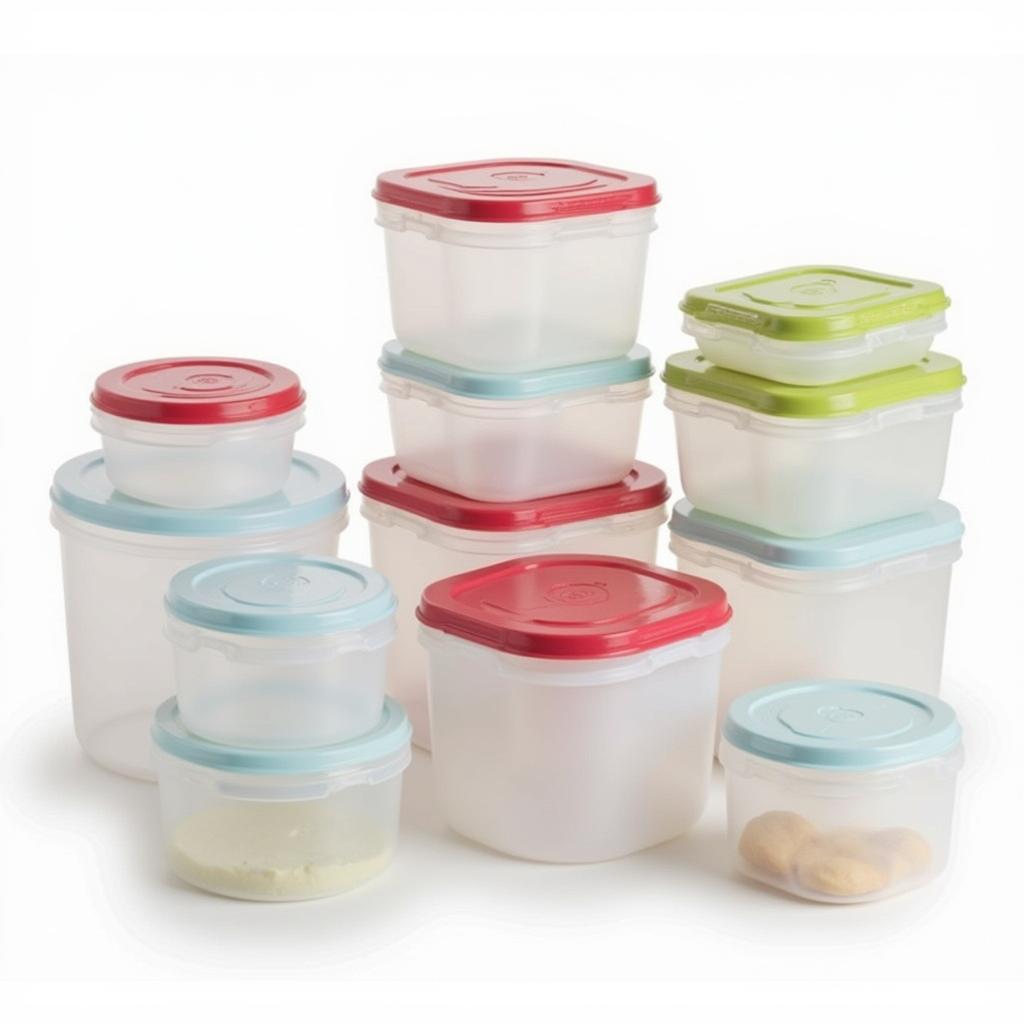Choosing the right Emergency Food Storage Containers is crucial for anyone looking to prepare for unexpected situations. Whether it’s a natural disaster, power outage, or economic hardship, having a reliable food supply can provide peace of mind and essential sustenance. This comprehensive guide will explore the importance of emergency food storage and provide valuable insights into selecting the best containers to keep your food safe, nutritious, and readily available when you need it most.
 Various Types of Emergency Food Storage Containers
Various Types of Emergency Food Storage Containers
Why Invest in Emergency Food Storage Containers?
Stocking up on non-perishable food items is essential, but using appropriate containers goes beyond simply storing food; it’s about maintaining quality, preventing spoilage, and ensuring longevity. Here’s why investing in dedicated emergency food storage containers is paramount:
- Pest Protection: Properly sealed containers create a barrier against insects, rodents, and other pests that can decimate your food reserves.
- Moisture Control: Moisture can lead to mold, mildew, and spoilage. Choosing containers with airtight seals safeguards your food from humidity and moisture damage.
- Extended Shelf Life: Emergency food storage containers help preserve the freshness, flavor, and nutritional value of your food, allowing for longer-term storage.
- Organization and Accessibility: Utilizing different container sizes and labeling them clearly allows for efficient organization and easy access to specific food items when needed.
Choosing the Right Emergency Food Storage Containers: Factors to Consider
 Comparing Different Food Storage Containers
Comparing Different Food Storage Containers
Selecting the appropriate emergency food storage containers is crucial for maintaining the quality and safety of your food supply. Consider these factors when making your decision:
1. Material Matters:
- Plastic: Lightweight, affordable, and readily available, plastic containers are a popular choice. Opt for BPA-free, food-grade containers that are thick and durable. Look for containers with airtight lids and consider using oxygen absorbers for added protection against spoilage.
- Glass: Glass containers offer excellent protection against moisture and pests. They are also reusable and do not retain odors or flavors. However, they are heavier and more prone to breakage. Consider using protective sleeves or storing them in sturdy crates.
- Stainless Steel: Highly durable and resistant to rust and corrosion, stainless steel containers are an excellent choice for long-term food storage. They are also lightweight and easy to clean. However, they can be more expensive than other options.
2. Size and Shape:
The ideal container size depends on your household size and the quantity of food you plan to store. Consider a variety of sizes to accommodate different types of food and optimize storage space. Square or rectangular containers tend to be more space-efficient than round containers.
3. Airtight Seals:
Airtight seals are crucial for preventing moisture, air, and pests from infiltrating your food storage. Look for containers with rubber gaskets, locking mechanisms, or other features that create a secure seal.
4. Stackability:
Choose containers that are designed for easy stacking to maximize vertical space and maintain an organized storage system.
Essential Tips for Using Emergency Food Storage Containers
- First In, First Out (FIFO): Practice FIFO by rotating your food stock regularly. Use the oldest food first and replenish your supply with fresh items.
- Label Clearly: Label each container with the food item’s name, quantity, and storage date. This makes it easy to identify and track your food supply.
- Store in a Cool, Dry Place: Choose a storage location that is cool, dry, and away from direct sunlight, heat sources, and potential pest entry points. A dedicated pantry, basement, or cool closet are ideal options.
- Regularly Inspect Your Storage: Periodically check your food storage containers for signs of damage, pests, or spoilage. Discard any compromised items immediately.
Conclusion
Investing in emergency food storage containers is a proactive step towards ensuring your family’s well-being during unexpected events. By selecting the right containers and following proper storage practices, you can maintain a safe, nutritious, and readily available food supply, providing peace of mind and essential sustenance when it matters most. Remember, proper food storage is not just about survival; it’s about maintaining quality of life even in the face of adversity.
For those seeking exceptional food experiences in their daily lives, Mina Cones Food offers a delectable array of culinary creations. Explore our website for inspiration, including creation food, pet food pantry las vegas, and much more.
FAQs about Emergency Food Storage Containers:
1. How much food should I store in an emergency food storage container?
The ideal amount varies depending on your family size and dietary needs. However, a general guideline is to store a 2-week supply of food per person.
2. Can I store water in emergency food storage containers?
While some food-grade containers can store water, it’s best to use dedicated water storage containers designed for this purpose.
3. Where should I store my emergency food supply?
A cool, dry, and dark location is ideal for storing emergency food. Basements, pantries, and closets are good options.
4. How often should I rotate my emergency food supply?
Aim to rotate your food supply every 6-12 months to ensure freshness and prevent spoilage. Follow the FIFO method, using the oldest items first.
5. What are oxygen absorbers, and should I use them?
Oxygen absorbers are small packets that absorb oxygen from the air inside containers, helping to prevent spoilage and extend the shelf life of food. They are particularly beneficial for long-term food storage.
Need help with your culinary needs? Contact us!
Phone: 02437655121
Email: minacones@gmail.com
Address: 3PGH+8R9, ĐT70A, thôn Trung, Bắc Từ Liêm, Hà Nội, Việt Nam
Our dedicated customer support team is available 24/7 to assist you.